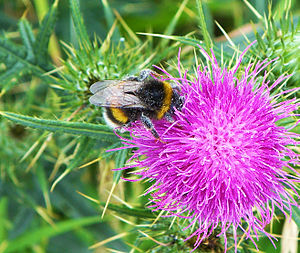Field bumblebee
| Field bumblebee | ||||||||||||
|---|---|---|---|---|---|---|---|---|---|---|---|---|

European bumblebee ( Bombus ruderatus ) |
||||||||||||
| Systematics | ||||||||||||
|
||||||||||||
| Scientific name | ||||||||||||
| Bombus ruderatus | ||||||||||||
| ( Fabricius , 1775) |
The European bumblebee ( Bombus ruderatus ) is a rare species of bumblebee that is native to Europe from the Iberian Peninsula to southern Fennoscandinavia and all of Germany. The field bumblebee lives in colonies of 50 to 100 insects.
features
The females of the field bumblebees are 21 to 24 millimeters in size, while the males reach 15 to 17 millimeters and the workers measure only 11 to 18 millimeters. The wingspan of the wings ranges from 40 to 43 millimeters for the females, 30 to 33 millimeters for the males and 21 to 35 millimeters for the workers. Both the head and the trunk , which are 12 to 13 millimeters in the females, 8 to 10 millimeters in the males and 8 to 10 millimeters in the workers, are very long compared to other bumblebee species. In terms of color, the field bumblebee resembles the garden bumblebee ( Bombus hortorum ) and the clay bumblebee ( Bombus argilaceus ). On the thorax , on the side facing the head, there is a yellowish-brown, broad stripe. However, this is absent in some individuals or is less pronounced. There is also another bandage at the rear end of the thorax and on the 1st tergite of the abdomen . The Tergite 5 and 6 have a white fur.
Way of life
The habitat of this bumblebee species are open landscapes, especially meadows, pastures, embankments and ditches. The main flowering plants of the polylectic animals are field ziest , field beans , red clover , motherwort , black nettles , white clover , vetches , Veneta field peas , comfrey and willowherb . The flight time of the univoltine species begins at the end of April with the overwintered females. The first males appear in mid-July and the first young females follow towards the end of July. According to the Red List of Bees in Germany, it is classified in category G (endangered, status unknown).
It was intentionally introduced in Chile in 1982 to do pollination work. It is now spreading invasively on the South American land mass.
Reproduction
The field bumblebee usually reproduces in the nests of mice and thus underground. The nests are partially parasitized by the bearded cuckoo bumblebee ( Bombus barbutellus ).
Web links
swell
- ↑ a b c d H.-J. Martin: Bumblebee - Bombus ruderatus . In: www.wildbienen.de . ( wildbienen.de [accessed on October 26, 2007]).
- ↑ Huib Koel: Grote tuinhommel . In: www.wildebijen.nl . ( wildebijen.nl [accessed October 26, 2007]).
- ↑ a b Alexander Schlecht: Hummel profile - field bumblebee . In: www.bombus.de . ( bombus.de [accessed October 26, 2007]). Hummel profile - field bumblebee ( memento of the original from April 16, 2009 in the Internet Archive ) Info: The archive link was inserted automatically and has not yet been checked. Please check the original and archive link according to the instructions and then remove this notice.
- ↑ Regula Schmid ‐ Hempel, Michael Eckhardt, David Goulson, Daniel Heinzmann, Carlos Lange, Santiago Plischuk, Luisa R. Escudero, Rahel Salathé, Jessica J. Scriven, Paul Schmid ‐ Hempel: The invasion of southern South America by imported bumblebees and associated parasites . In: Journal of Animal Ecology . tape 83 , 2014, ISSN 1365-2656 , p. 823–837 , doi : 10.1111 / 1365-2656.12185 (English, first published November 21, 2013, available via DOI as PDF with 1.8 MB).